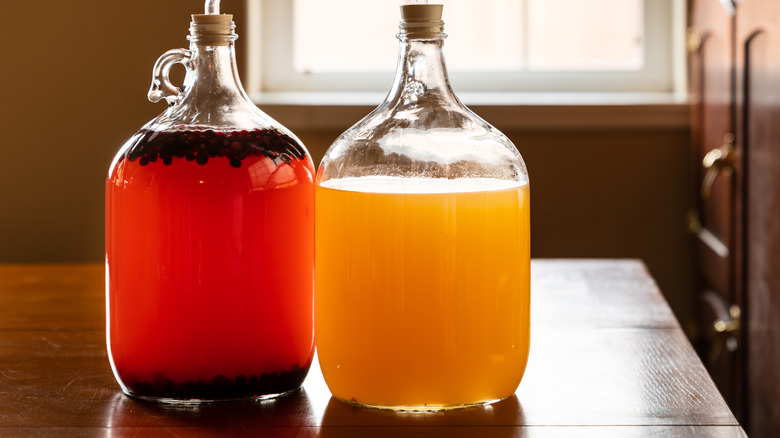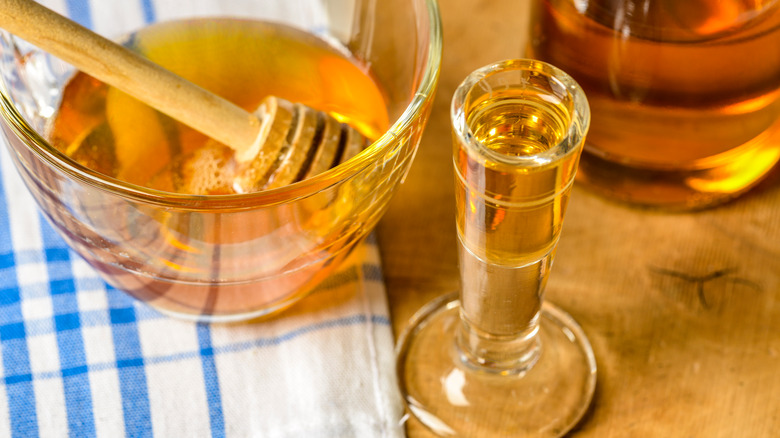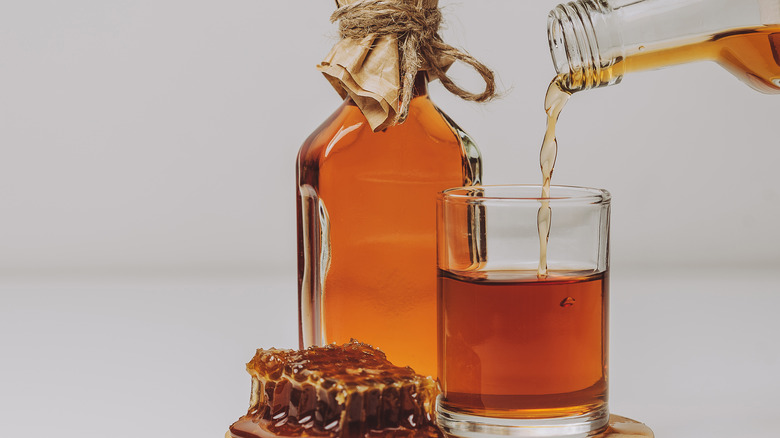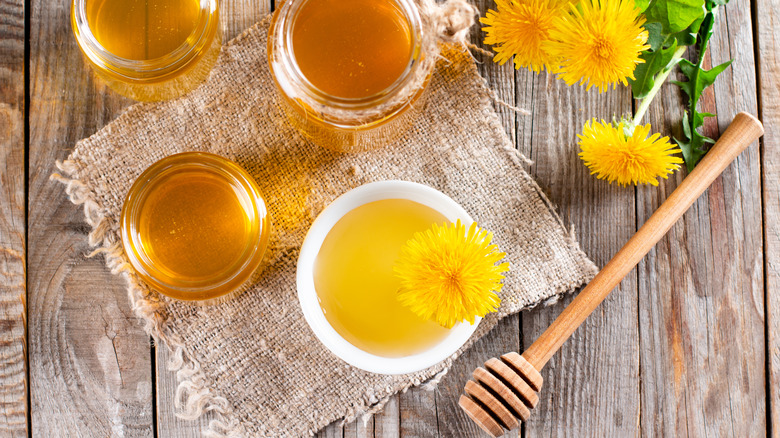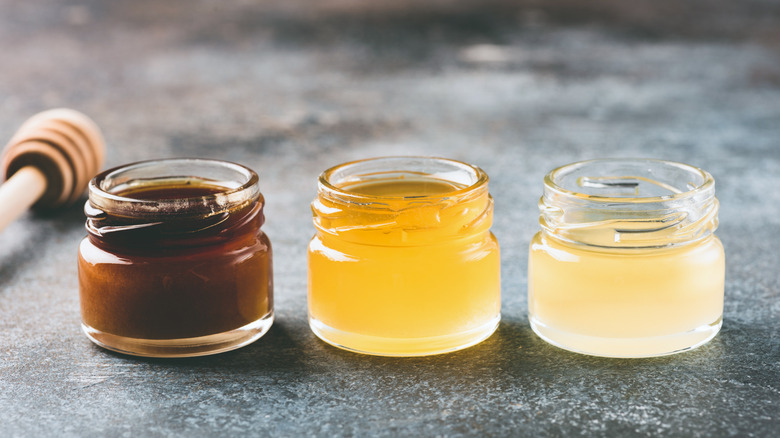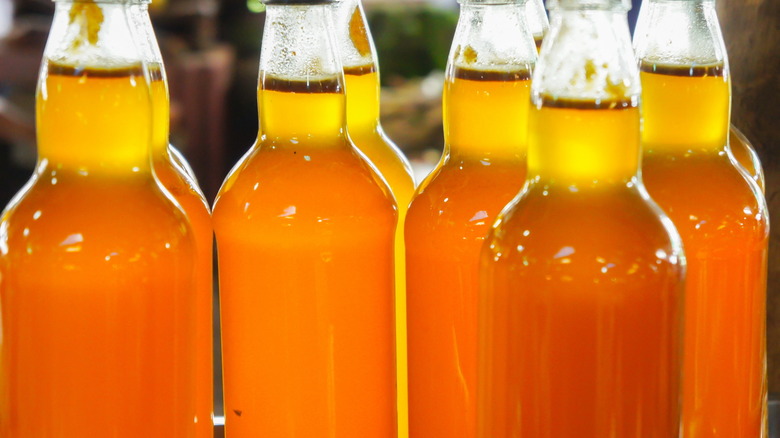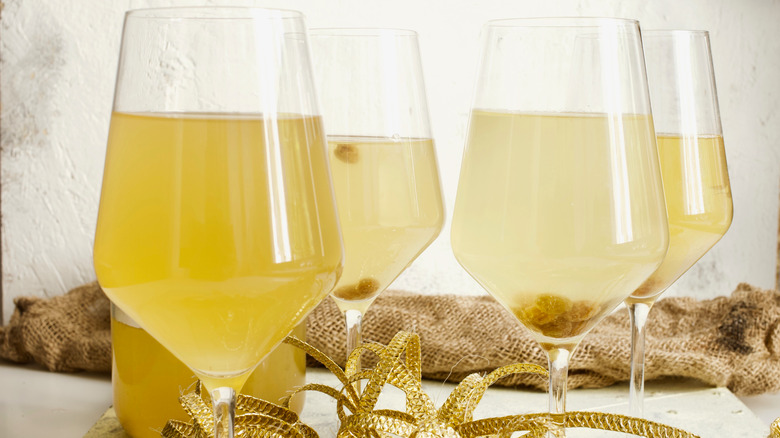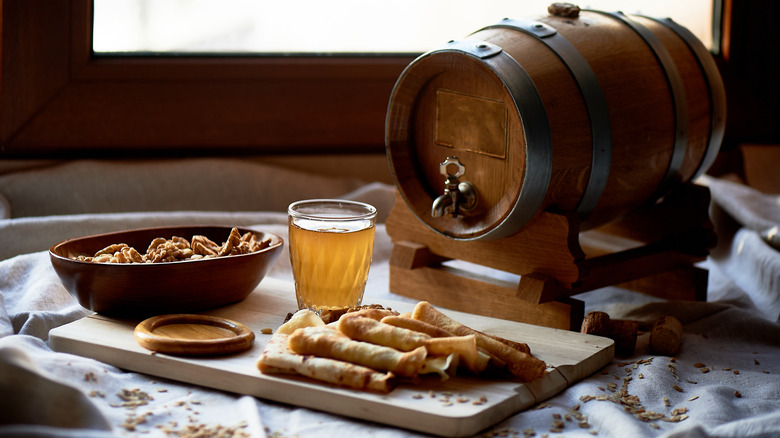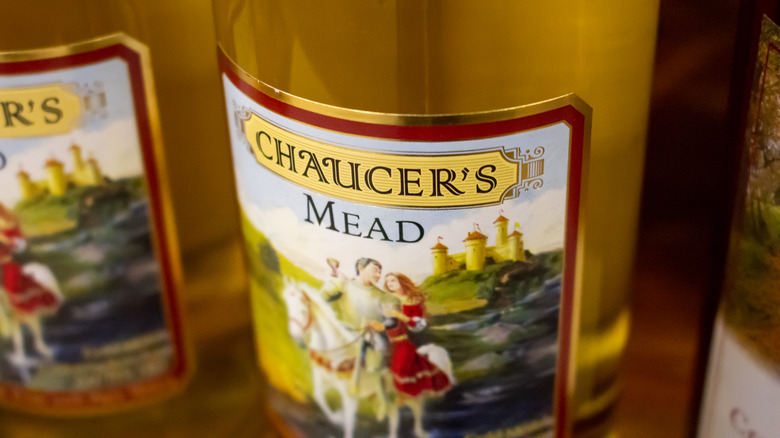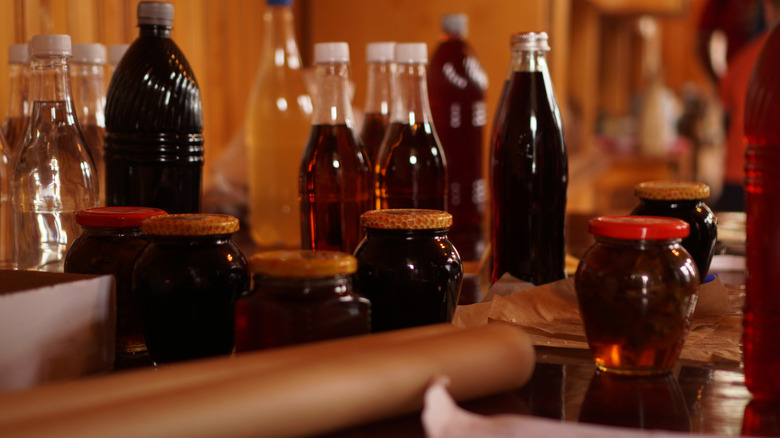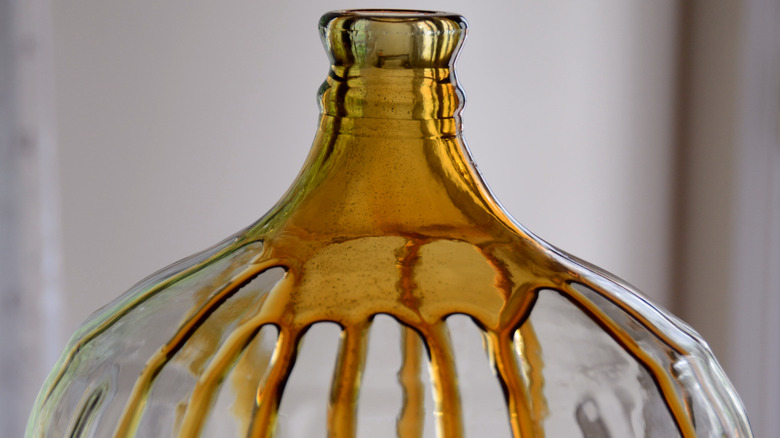What Is Mead, And What Does It Taste Like?
While walking the aisles at your local liquor store or the alcohol aisles at your local grocery store, you may have come across bottles of mead and wondered what it is and what it tastes like. It's often grouped with saké and other specialty wines, making you ask if it's just another wine varietal to mark off your list. If that's the case, why are there so many different types and flavors? Is it even wine at all?
If you've found yourself utterly stumped by mead but afraid to dive in without more information, you can rest easy. We're covering all the bases on mead, including the what, where, and why of how it's made, along with how it tastes, how much of a buzz you can expect to get from it, and what kinds of foods to enjoy with it. You may not become a total mead expert, but you'll certainly have a starting point to go out and try some (or maybe even try brewing your own).
You may have discovered mead at a Renaissance festival
For those who frequent Renaissance fairs and festivals, mead is nothing new. It's on the menu right alongside giant turkey legs and is as much a part of the day for many festival-goers as the jousting tournaments and performers who refuse to break character. While you aren't likely to get any fancy mead at a Renaissance festival (more like the two-buck Chuck of Nottingham), it's a great way to get your feet — err, mouth — wet.
While some of the foods and drinks you find at Renaissance fairs and festivals aren't authentic to the period, mead is an exception. According to Encyclopedia Britannica, mead was akin to a sparkling table wine during the Middle Ages. While perhaps not on the tables of poor farmers and peasants, royalty in the Middle Ages certainly imbibed a goblet or two of mead at mealtimes. So go ahead, give it a try while you watch a pair of cosplayers duke it out for most authentic outfit and persona. Huzzah!
It's sometimes called honey wine, but mead isn't wine
Despite not actually being wine, mead is sometimes referred to as honey wine. In its most basic form, Mead is made from fermented honey and water. Wine, on the other hand, is made from fermented fruit juice (most often grapes). The use of the term "honey wine" to refer to mead likely comes from the fact that the fermentation process is similar to winemaking.
Whether "honey wine" and "mead" can be used interchangeably is mostly a matter of preference, though there are some requirements for what constitutes mead. According to batchmead.com, it must be 60% or more fermented honey to be considered mead. While some wines may use honey as a sweetener or as one of the fermented ingredients alongside fermented fruit, they're not mead. So where does the confusion about terminology originate? According to the folks at Hidden Legend Winery, the Alcohol & Tobacco Tax and Trade Bureau, which regulates alcohol in the United States, required mead to be labeled as "honey wine" until 2016.
Is mead gluten-free?
Because the process of making mead typically includes water, honey, and sometimes yeast, most mead is naturally gluten-free. Before those among us with celiac disease and gluten intolerance rejoice, there is a catch. There's always a catch.
Many craft meads available at restaurants and bars and in your local alcohol aisles are aged in barrels to produce unique flavor combinations to stand out among the competition. If the mead you're buying was aged in barrels or casks previously used to hold beer, slow your roll because it's no longer considered gluten-free. The same thing goes for mead fermented using brewer's yeast, which is a byproduct of making beer and contains gluten. As long as you are sure your mead has not been produced in these ways, you should be good to go. Of course, the safest bet is to always check the label, as many meads produced in the United States now carry a gluten-free label.
Mead has been made for millennia
Although you may just be hearing about mead for the first time, it's far from a new drink. In fact, it's considered the oldest alcoholic drink in the world. According to the Encyclopedia Britannica, the consumption of mead has been traced as far back as China in the 7th millennium BCE. According to NPR, it was also one of the preferred drinks of ancient Egyptians and Vikings. Wine Enthusiast magazine goes even further, asserting that mead can be traced back 20,000 years to prehistoric Ethiopia, where feral bees were making honey that was eventually fermented with water to make mead.
Regardless of when exactly mead originated, we know that it's older than both beer and wine by thousands of years. According to Dave Goulson in his article, "The Beguiling History of Bees" for Scientific American, the oldest bee found preserved in amber is approximately 80 million years old. While it isn't a honeybee, that gives you some idea of the timeline we're working with. Where there were bees, there was honey, and where there was honey, there was mead.
Mead was used medicinally in the past
Honey has many benefits that have been used medicinally for thousands of years. Several of those benefits are conferred on mead because the honey in mead-making is not typically heated to boiling. The Ancient Greeks believed mead was the nectar of the gods or the fabled ambrosia that confers immortality to those who drink it. It is referenced by the Sanskrit name "madhu" in the Rig Veda, a collection of Sanskrit hymns from between 1700 and 1100 BC, in which it is said there was a flowing spring of mead in the god Vishnu's heaven. The Romans also believed mead had properties of preservation.
Some varieties of mead contain additional spices and herbs thought to boost the medicinal properties of the drink. While there are no clinically proven benefits to drinking mead, the drink was used as a tonic for treating many ailments. The name for mead that has additional spices and herbs, metheglin, comes from the Welsh words "meddyg" for "medicinal" or "healing" and "llyn" for "liquor."
The type of honey helps determine the flavor
One factor in a mead's flavor is the type of honey used to make it. You may already know that different types of honey are made when the bees that make it obtain pollen from a particular source. You've probably seen clover honey, orange blossom honey, and Manuka honey, but it also comes in varieties like sage, eucalyptus, acacia, chestnut, rosemary, and more! While the honey won't taste overwhelmingly like the flora used to make it, the varieties do have unique flavors and qualities that impact mead.
The honey in mead is what gets fermented, so the honey itself is subtle, giving it a flavor somewhere between wine and beer. What distinguishes many types of mead is what flavors are added to it after the fermentation process. Some mead varieties go all in on honey and add unfermented honey at the end, while others add flavors from different fruits, herbs, and spices. Further adding to the complexity of flavor is the aging process some mead makers use. The best way to figure out what mead tastes like is to try a few!
There are many varieties of mead
There are many different types of mead. Most traditional mead (also called "show mead") is just honey, water, and yeast to help speed up the fermentation process. Sack mead, also called "great mead," has a higher ratio of honey to water than traditional mead. On the other hand, hydromel (also called "session mead") has a higher percentage of water. "Melomel" is the term for mead with fruit added, while metheglin is mead made with spices.
Pyment is fermented with grapes (though honey is still the primary source of fermentation), while capsicumel (or spicy mead) has peppers added. Cyser is mead fermented with apples. Bochet is a mead made with boiled or caramelized honey. There are meads made with coffee and some that have maple syrup in place of a portion of the honey. In the African nations of Ethiopia and Eritrea, the variety of mead you'll find is called t'ej. What differentiates t'ej from other types of mead is the use of a medicinal shrub called gesho. Other regions have their own takes on mead, using different spices and herbs. The combinations are seemingly endless.
Mead's alcohol content varies widely
In general, the alcohol content of mead ranges anywhere from 3% by volume (ABV) to a whopping more than 20% ABV. Because there are so many different types of mead, it's probably no surprise that the alcohol content of different meads also varies a lot. Great mead (sack mead) has a higher alcohol content than other mead because it has a higher percentage of honey. More honey means more sugar to ferment into alcohol. Hydromel (session mead) is made with a higher percentage of water than honey and, therefore, naturally has a lower alcohol content.
On average, a glass of mead has a higher alcohol content than a typical beer or glass of wine (save for the intentionally higher ABV beers and wines). That means you'll want to be careful as a mead newcomer. The drink of the gods can pack quite a punch!
Mead can be paired with lots of foods
As with alcoholic beverages, pairing mead with food is partly about personal preferences and partly about making sure your food can stand up to your drink (and vice versa). Traditional mead that is made with only honey, water, and yeast is relatively light and best paired with light dishes like seafood and salads. For sweeter, fruitier mead like melomel, you'll want heartier dishes (think strong cheeses and red meat) that add a bit of saltiness and savoriness. For dryer mead, try it alongside grilled vegetables and smoky meat.
Another factor is acidity. Acidic foods can make mead taste sweeter, while those low in acidity can make the mead taste dry. If you have a spiced mead or a mead with added flavors, avoid competing flavors in your food choices. Of course, like wine, you can't go wrong with a mead and cheese pairing or mead and charcuterie.
Mead is mentioned throughout literature
It's no surprise that a drink as old as mead can be found throughout classic literature. In "The Canterbury Tales" by Geoffrey Chaucer, we see mead used "The Miller's Tale" as a means of courting a "town-bred" lady. The drink has become so closely associated with the author that Chaucer's Mead has become the go-to mead at many Renaissance festivals.
In the epic poem "Beowulf," mead is a focal point of happiness and celebration in the mead hall known as Heorot. We're told Heorot is a place where mead flowed freely before the beast Grendel laid siege to it for 12 years. There, Beowulf meets and defeats Grendel, after which mead is consumed in celebration.
If poetry isn't your thing, you can always look to "The Lord of the Rings" for your literary mead fix. In J.R.R. Tolkien's Middle Earth, miruvór is the reviving cordial of the Elves in Rivendell. As you may have guessed, given the restorative properties often attributed to mead in the Middle Ages and before, in the Elvish poem "Namárië" (Galadriel's lament), miruvór is translated to English as mead.
It's also a drink long enjoyed by royals
Of course, if a drink was said to be enjoyed by the gods, then royalty throughout history had to have it as well. According to Honey: A Global History by Lucy Long, King Solomon and the Queen of Sheba, upon meeting, toasted with t'ej, the variety of mead found in Ethiopia and Eritrea. They weren't the only royals with a taste for mead, though. According to the British Library, Queen Elizabeth I preferred metheglin, with added herbs and spices. The story goes that the queen's beekeeper (bees at the time were used not only for their honey but for beeswax candles), Charles Butler, wrote down the recipe for her majesty's favorite metheglin, and it has purportedly been adapted to modern methodology and ingredients. It is still made today.
Whether or not current royalty (in Britain or beyond) drink mead is up for speculation. However, it's certainly no longer a drink reserved for royals.
The term honeymoon can be traced to mead
These days, a honeymoon lasts anywhere from a few days to a couple of weeks (likely limited by whatever personal or vacation time you can take off work), but the term describes a time when that period lasted for the cycle of the moon —a month. While the "honey" part of the name typically refers to the sweet period right after a wedding, its origins are in our favorite honey-based drink.
The term comes from the Old English "hony moone" and the European tradition of supplying the newlyweds with enough mead to last them for a month. As we know, mead was thought to confer all sorts of medicinal and somewhat magical properties, such as health and immortality. Drinking mead for the moon cycle after getting married was thought to bring newlyweds good luck and fertility in their marriage, as mead was also thought to be an aphrodisiac.
Craft mead is a booming trend
While you used to be able to find mead almost exclusively at Renaissance fairs and festivals, these days, you can find it practically anywhere you find beer and wine. Chris Weber, the then-president of the American Mead Makers Association, told NPR that in the year 2000, there were only 20 to 25 commercial mead makers in the United States, but by 2014 (when he gave his interview), there were nearly 250. That number has only continued to grow. According to the American Mead Makers Association, as of 2020, there were around 450 commercial meaderies in the United States, with an additional approximately 50 breweries and wineries that were making at least one mead product as part of their production.
Whether the current rise in mead brands is due to its relative novelty or something else, there's no denying that mead is more popular now than it has been at any other time in the recent past.
You can brew mead at home
Whether you want to get in on the booming trend of making mead and start branching out into distribution, or you just want to try brewing it at home to see what you end up with, mead-making requires few ingredients and tools. The most important thing for any home brewing is sterilizing your equipment. The right gear, some high-quality honey (if you know a local beekeeper and can attest to its origin, even better), mead yeast, something to feed your yeast (also called yeast nutrition), water, whatever fruit and spices you'd like to add, and a recipe are the main things you'll need to get started. Well, that and some patience while the fermentation occurs.
Perhaps you'd like to try your hand at Queen Elizabeth's metheglin, or maybe a traditional or session mead is more your style. If it doesn't come out perfect on the first try, don't give up. After all, if they could make mead thousands of years ago, surely you can pull this off.
